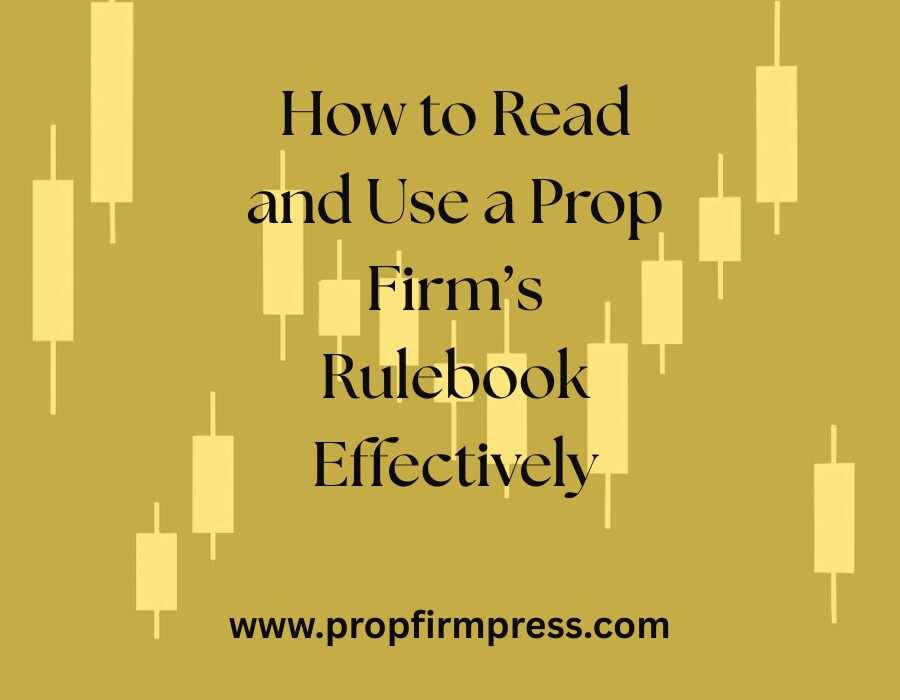Why Reading the Rulebook Is Your First Trading Edge
Too many traders jump into a prop firm evaluation with a good strategy—but zero awareness of the rules that could disqualify them. Reading and understanding the rulebook isn’t optional. It’s your first defense against avoidable failure. Whether you’re using Bulenox, Lucid Trading, or Funding Ticks, each firm has unique guidelines. Learning to interpret and follow them gives you a serious edge over the competition.
Most Common Rulebook Sections (and What They Mean)
- Profit Target: The amount you must make to pass
- Drawdown: How much you can lose before failing
- Daily Loss Limit: Max you can lose per day
- Scaling Plan: When you can increase size
- Consistency Rules: Limits on trade frequency/lot sizing
- News Trading Rules: When not to trade around reports
Each rule affects how you should structure your trades, strategy, and risk model.
Step 1: Read the Rulebook Twice
Skimming isn’t enough. Read it once as an overview. Then again, line by line, noting any term or limit you’re unsure of. Look for rules like:
- Trailing vs static drawdown
- Lot size limits
- Weekend holding restrictions
- Number of trading days required
Highlight these in a Google Doc or notebook to revisit.
Step 2: Translate Rules Into Personal Guidelines
Example: If the daily loss limit is $1,000 and you trade 3 setups per day, then your max loss per trade must be <$330.
This becomes a personal rule: “Never risk more than $300 per trade during the evaluation.”
Step 3: Check for Reset and Retake Policies
Some firms let you reset an evaluation for a fee, others allow free retakes if rules were followed. This can influence your trading aggression.
- Reset-friendly firm: More flexibility on size/risk
- No-reset firm: Must be more conservative
Knowing the policy can help you plan your risk better.
Step 4: Spot Hidden Restrictions
Some prop firms include fine print that can cause you to fail even if your P&L looks great. Watch for:
- Minimum trade days
- Lot sizing consistency
- News blackout times (even for futures)
Example: Passing the profit target in 3 days but needing 5 trade days? That’s an automatic reset unless you stretch it out.
Step 5: Build a Rule Summary Sheet
Create a single-page cheat sheet using info from the rulebook. Include:
- Profit target, drawdown, daily limit
- Allowed instruments
- Restricted hours
- Violation triggers
Use this every day before and after trading. Reference it like a pilot’s preflight checklist.
Step 6: Recheck Rules After Platform Updates
Prop firms often change policies. If a firm updates its dashboard, adds new funding tiers, or changes risk models, they usually update the rulebook too. Re-read after:
- Website redesigns
- Emails about system changes
- Adding new account types
Step 7: Ask Support for Clarification
If anything is unclear—ask. Send an email or use chat to confirm:
- “Does trailing drawdown move during open trades?”
- “Can I hold trades overnight in the funded account?”
- “Do I need to trade every day to pass?”
Get it in writing. Screenshots of replies are helpful for disputes.
Step 8: Match Strategy to the Rules
Don’t fight the rules. Adapt your approach. If your strategy uses wide stops, avoid firms with tight drawdowns. If you trade news spikes, avoid firms with news bans. Let the rulebook help you choose which firm to challenge, not the other way around.
Step 9: Track Violations in a Journal
Every time you break a rule (even in sim or practice), log it:
- What rule?
- Why did it happen?
- What will prevent it next time?
This builds awareness and reduces future mistakes.
Step 10: Update Your Trading Plan
Once you’ve understood the rules, add them directly to your trading plan:
- Max daily risk: $300
- No trades before 9:30 AM EST
- Only use allowed markets (e.g., NQ, ES)
- Minimum 5 trade days before stopping
This removes guesswork during the challenge.
Prop Firm Rulebooks Aren’t Just Legal Docs—They’re Strategy Filters
Smart traders use the rulebook as a guide, not a limitation. Understanding what’s allowed helps you design systems that pass evaluations faster and with less stress.
Every evaluation you fail due to a technicality is a wasted opportunity. Read the rules. Use them. And trade within them—like a professional.
